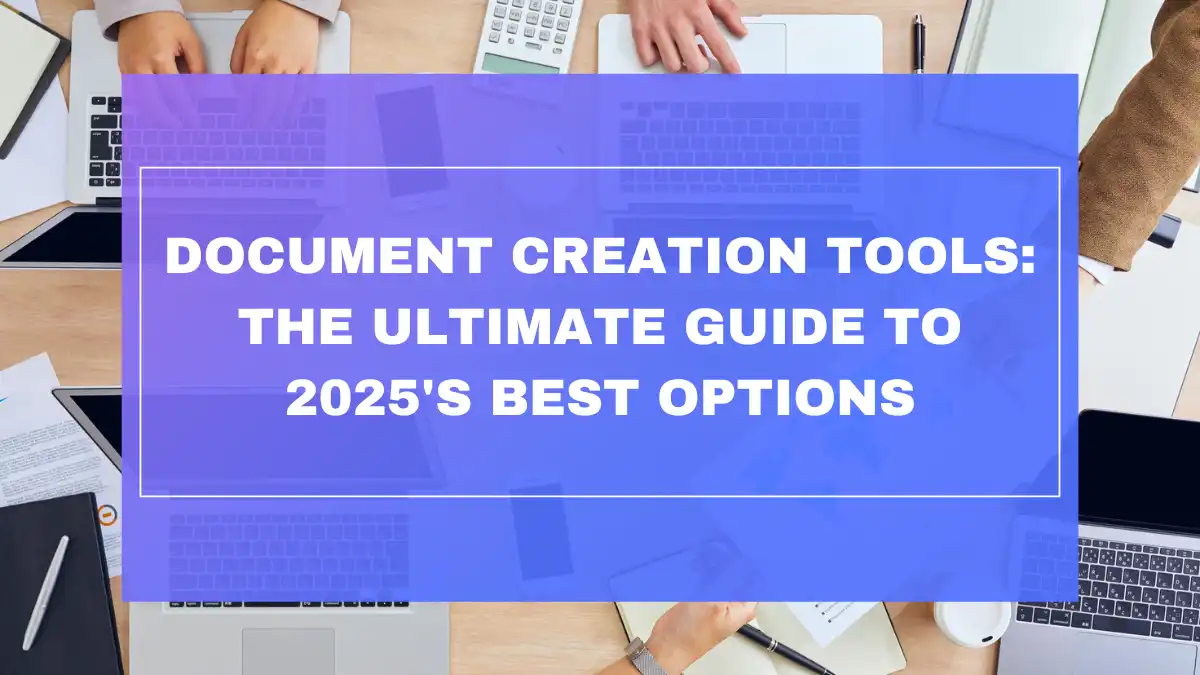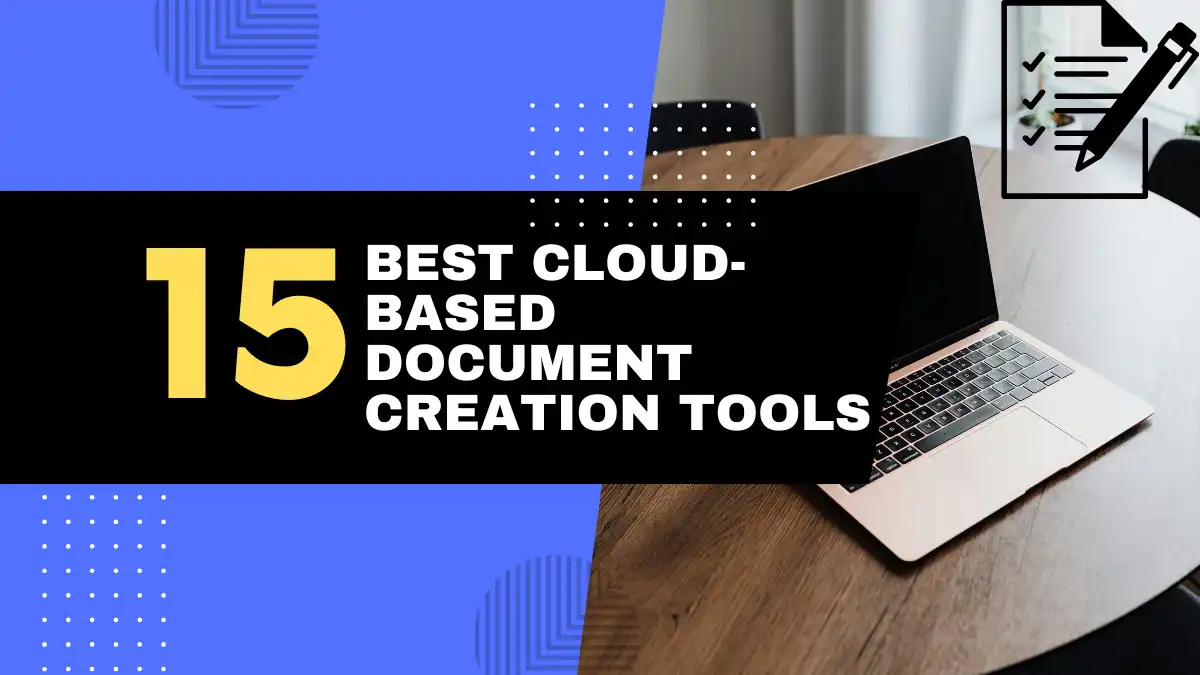
Introduction: Power Up Your Productivity with the Best Windows Document Creation Software
Staring at a blank screen, wondering which tool will best bring your ideas to life? You’re not alone. Millions of Windows users face this dilemma daily, toggling between various apps trying to find their perfect document creation match. Whether you’re drafting business reports, writing a novel, or simply taking notes, the right software can transform your workflow from frustrating to fulfilling.
Windows as a Document Creation Hub: Why Choosing the Right Software Matters
Windows remains the dominant operating system in professional environments, powering over 70% of desktop computers worldwide in 2025. This ubiquity makes selecting the right document creation software crucial for productivity. The right tool doesn’t just store your words—it shapes how you think, organize information, and collaborate with others.
Many users default to what came pre-installed on their device, missing out on specialized tools that could dramatically improve their specific workflow. A novelist has different needs than a technical writer, just as a student’s requirements differ from a corporate executive’s.
Beyond Microsoft Word: Exploring the Diverse World of Windows Writing Tools and Document Software
While Microsoft Word has long dominated the landscape, the document creation ecosystem has evolved dramatically. Today’s options range from lightweight markdown editors to comprehensive publishing suites, cloud-synchronized notebooks to specialized academic writing platforms.
The modern Windows user can choose from traditional desktop applications, web-based alternatives, or hybrid approaches that sync across devices. Each option presents unique advantages in terms of features, pricing, and specialization.
Understanding User Search Intent: What Windows Users Seek in Document Creation Software
When searching for document creation software, Windows users typically fall into several categories:
- Professionals seeking Microsoft Office alternatives (either for cost or feature reasons)
- Writers looking for distraction-free environments
- Teams needing real-time collaboration tools
- Specialized users requiring industry-specific features
- Budget-conscious individuals exploring free options
- Cross-platform users who work across multiple devices
By understanding your specific needs, you can navigate beyond default options to find tools that truly enhance your document creation process.
Key Features to Evaluate in Windows Document Creation Software
Core Features for Effective Document Creation on Windows
When evaluating document creation software for your Windows system, consider these essential features:
- Formatting Capabilities: How flexible is the text formatting? Can you easily create styles, headers, and maintain consistent formatting?
- File Compatibility: Does it support industry-standard formats like DOCX, PDF, and RTF? Can you seamlessly exchange files with colleagues using different software?
- Autosave Functionality: Does the software automatically save your work to prevent data loss during crashes or power failures?
- Windows Integration: How well does it integrate with the Windows environment, including file explorer, printing systems, and other native features?
- Spell Check and Grammar: Does it offer robust spelling and grammar checking to ensure error-free documents?
- Search and Replace: How powerful are the search tools for finding and replacing text throughout documents?
- Table Support: Can you easily create, edit, and format tables for data presentation?
- Performance: Does it run smoothly on your Windows machine without excessive resource consumption?
Advanced Features in Best Document Software for Windows for Power Users
Beyond basic functionality, power users should evaluate these advanced capabilities:
- Collaboration Tools: Real-time editing, commenting, and version tracking for team projects
- Templates and Styles: Pre-designed templates and style systems for consistent document creation
- Cloud Integration: Seamless syncing with cloud storage services like OneDrive, Google Drive, or Dropbox
- Automation Features: Macros, scripts, or AI assistants to automate repetitive tasks
- Advanced Layout Controls: Precise control over page layout, columns, text flow, and positioning
- Reference Management: Built-in citation tools or integration with reference managers for academic writing
- Language Support: Multilingual capabilities including spell-checking, translation, and language-specific formatting
- Accessibility Features: Tools for creating accessible documents, including screen reader compatibility and accessibility checking
- Security Features: Document encryption, password protection, and digital signatures
- Extension Ecosystem: Availability of add-ins, plugins, or extensions to enhance functionality
Top Document Creation Software for Windows: In-Depth Reviews & Recommendations for 2025
1. Best Overall Document Creation Software for Windows: Microsoft Word (Desktop)
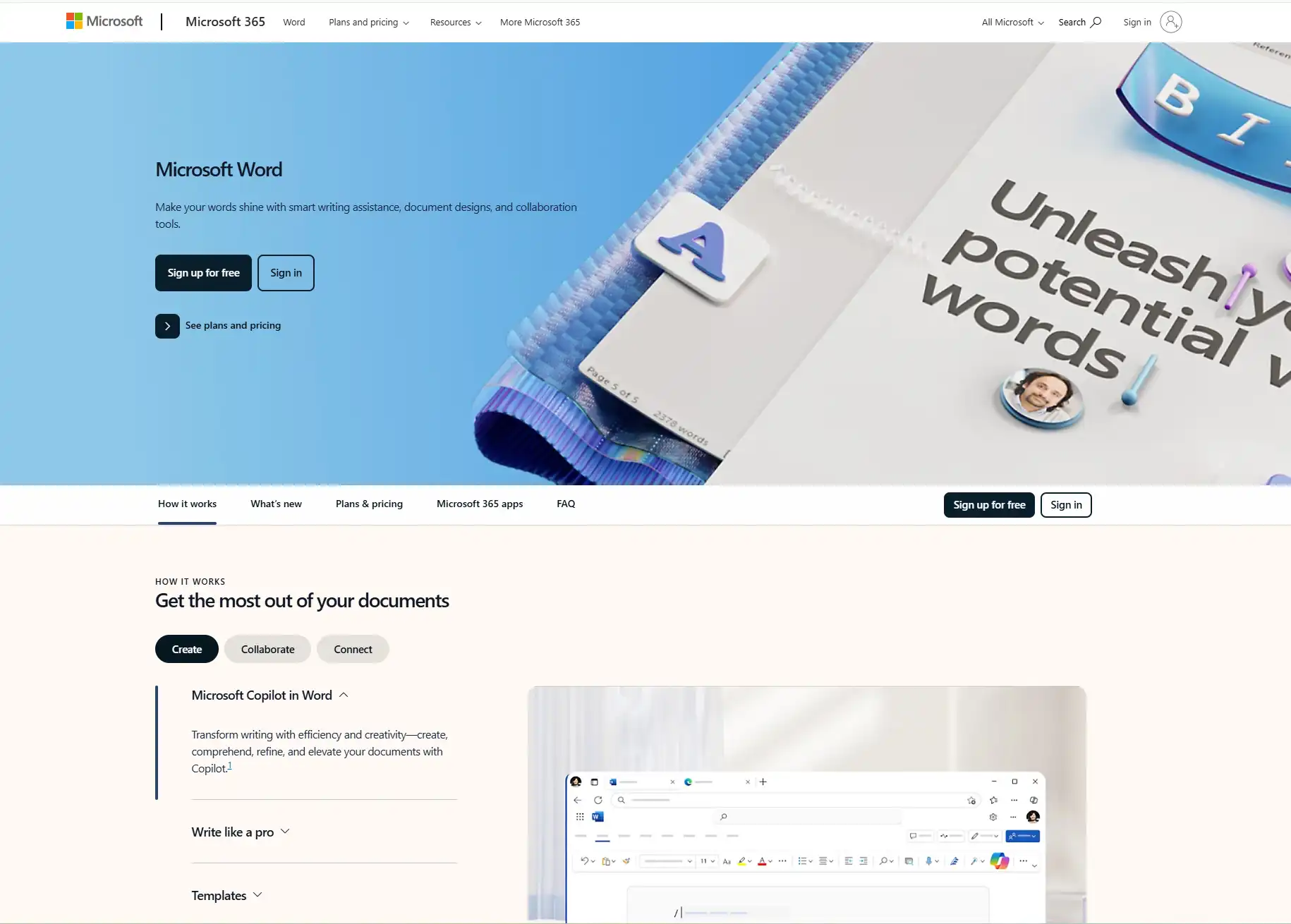
Despite numerous challengers over the decades, Microsoft Word remains the gold standard for document creation on Windows in 2025.
Key Features:
- Comprehensive formatting and layout tools
- Deep integration with Windows and Microsoft 365
- Real-time collaboration through OneDrive
- AI-powered editing assistance and design suggestions
- Extensive template library
- Advanced features for long documents (table of contents, cross-references)
Pros:
- Familiar interface that most users already understand
- Unmatched feature depth for professional document creation
- Regular updates with new functionality
- Excellent compatibility with other software
- Industry standard in most professional settings
Cons:
- Subscription cost may be prohibitive for some users
- Can feel overwhelming for simple document needs
- Resource-intensive compared to lighter alternatives
- Some features buried in complex menus
Ideal For: Most Windows users, professional document creation, users needing full feature sets, enterprise environments
Pricing & Platform: Paid Subscription via Microsoft 365 (approximately $69.99-$99.99/year for personal use), Windows Desktop
2. Best Free Document Software for Windows (Feature-Rich Suite): LibreOffice Writer
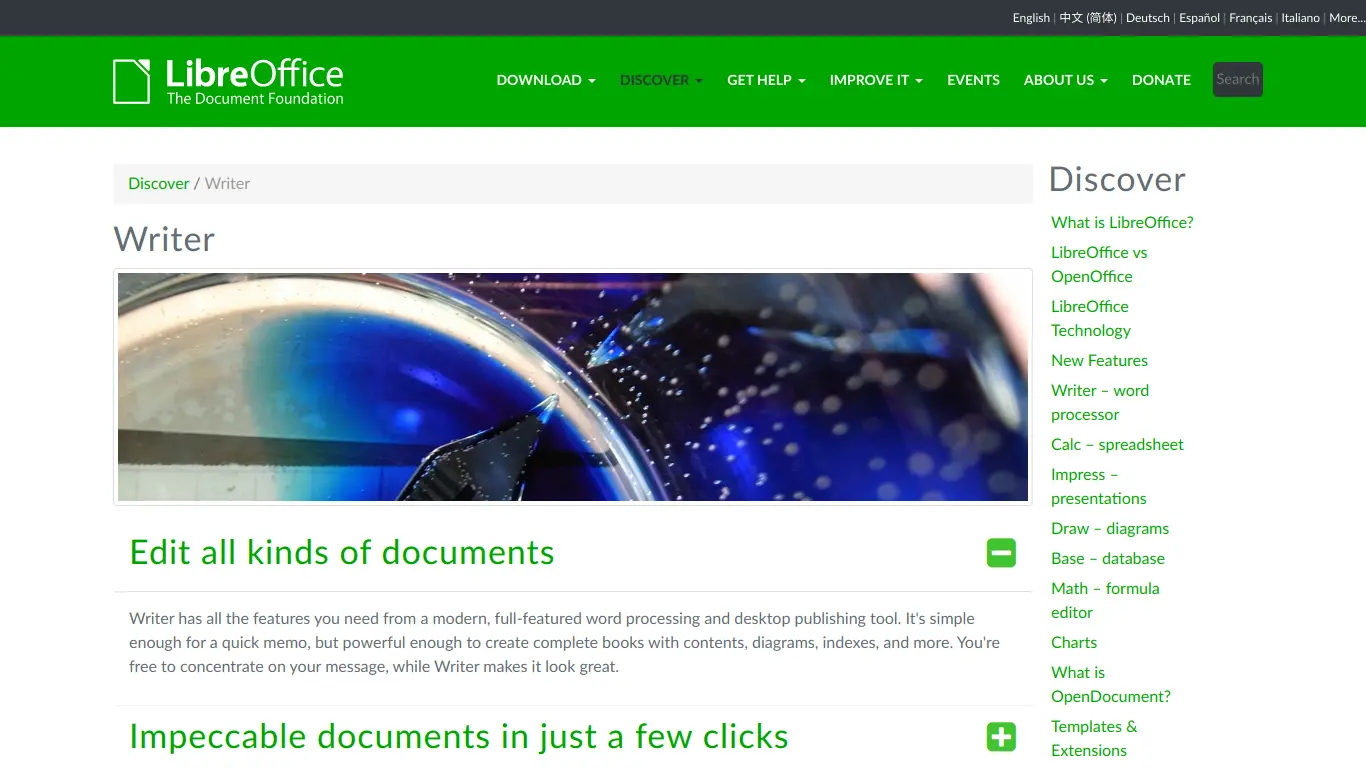
LibreOffice Writer stands as the most robust free alternative to Microsoft Word, offering a comprehensive desktop experience without subscription costs.
Key Features:
- Full-featured word processor with professional formatting capabilities
- Native support for Open Document Format (ODF)
- Strong Microsoft Office file compatibility
- Advanced page layout and desktop publishing features
- Extensive language support
- Macro and extension support
Pros:
- Completely free and open-source
- No subscription or hidden costs
- Robust feature set comparable to Microsoft Word
- Regular updates and community support
- Works offline without internet connection
Cons:
- Interface can feel dated compared to modern alternatives
- Occasional compatibility issues with complex Microsoft Office documents
- Steeper learning curve for Word users
- Lacks cloud integration out of the box
Ideal For: Budget-conscious Windows users, open-source advocates, users needing a free desktop suite, students
Pricing & Platform: Free, available for Windows, macOS, Linux
3. Best Free Document Software for Windows (User-Friendly): WPS Office Writer (Free Version)

WPS Office Writer offers a familiar, user-friendly experience that closely mimics Microsoft Office while maintaining a free tier.
Key Features:
- Microsoft Office-like interface for easy transition
- Strong compatibility with DOCX and other common formats
- Built-in cloud storage (1GB free)
- Templates and pre-designed elements
- PDF conversion tools
- Tabbed document interface
Pros:
- Highly intuitive for Microsoft Office users
- Minimal learning curve
- Excellent file compatibility with Office formats
- Lightweight performance compared to heavier suites
- Modern, clean interface
Cons:
- Free version contains advertisements
- Some advanced features restricted to premium version
- Privacy concerns with cloud integration
- Less customizable than some alternatives
Ideal For: Users seeking a free, user-friendly alternative, those wanting MS Office compatibility, home users
Pricing & Platform: Free Version with Premium options ($29.99/year), Windows, macOS, Linux, Android, iOS
4. Best Minimalist Writing Tool for Windows (Focus & Clarity): iA Writer
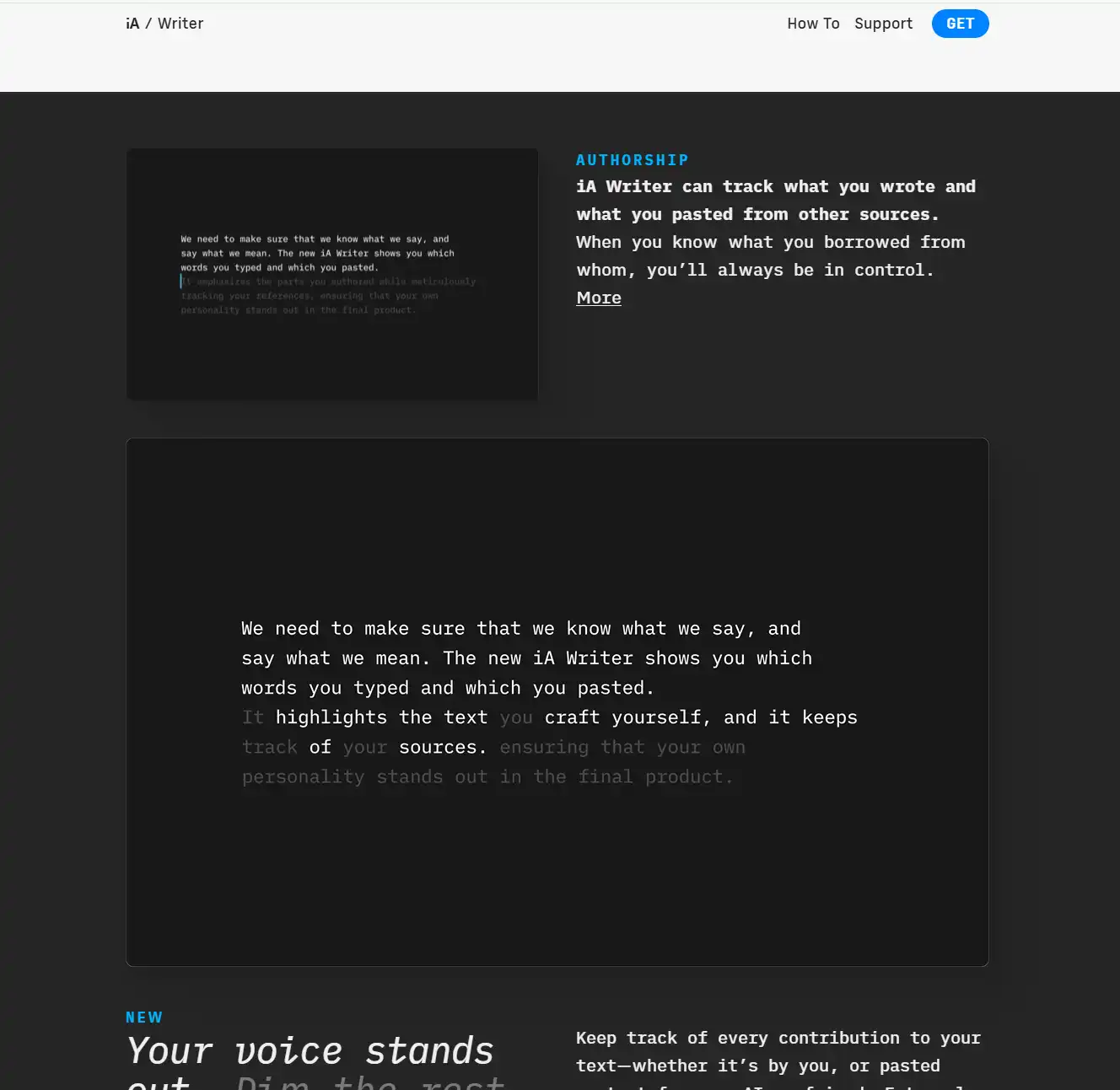
For those seeking a distraction-free writing environment, iA Writer offers a refined, minimal approach focused on the writing process itself.
Key Features:
- Distraction-free writing environment
- Markdown support with real-time preview
- Focus mode to highlight current sentence or paragraph
- Simple organization system
- Custom templates
- Reading time estimates
Pros:
- Clean, minimalist interface eliminates distractions
- Focus on the writing process rather than formatting
- Fast performance even on older Windows systems
- Excellent typography and reading experience
- Sync capabilities across devices
Cons:
- Limited formatting options compared to full word processors
- Not suitable for complex document layouts
- Learning curve for Markdown newcomers
- Paid software without a free tier
Ideal For: Writers seeking a distraction-free environment on Windows, Markdown users, focused writing tasks
Pricing & Platform: Paid ($49.99 one-time purchase), Windows, macOS, iOS, Android
5. Best Markdown Editor for Windows (Developers & Web Content): Typora

Typora combines markdown syntax with a seamless editing experience, making it ideal for developers and web content creators.
Key Features:
- Real-time Markdown rendering (WYSIWYG)
- Clean, distraction-free interface
- Support for tables, diagrams, and math equations
- Multiple export options (HTML, PDF, Word)
- Customizable themes
- File organization system
Pros:
- Seamless transition between editing and preview
- Excellent for technical documentation
- Good image handling capabilities
- Support for code blocks with syntax highlighting
- Fast performance
Cons:
- Moved from free to paid model in recent years
- Limited collaboration features
- Not designed for complex layouts
- Less suitable for non-technical users
Ideal For: Markdown enthusiasts on Windows, web content creators, developers, technical writers
Pricing & Platform: Paid ($14.99 one-time purchase), Windows, macOS, Linux
6. Best Note-Taking App that Can Create Documents on Windows: Evernote (Windows Desktop App)
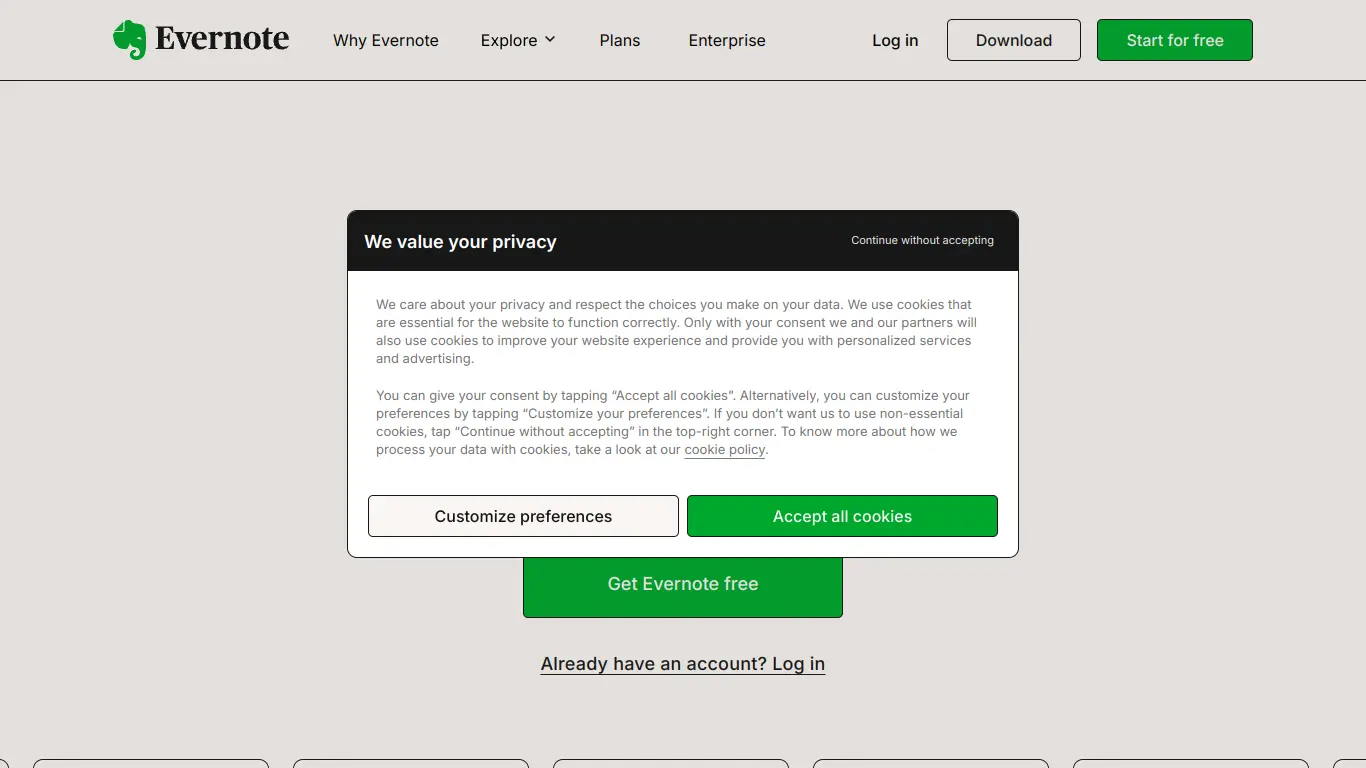
Evernote bridges the gap between quick notes and formal documents with its powerful organization and formatting capabilities.
Key Features:
- Hierarchical notebook and tag organization
- Rich text editing with formatting options
- Web clipper for saving online content
- OCR for searching text in images
- Cross-device synchronization
- Collaboration features
Pros:
- Excellent for organizing research and ideas
- Powerful search capabilities across all notes
- Seamless syncing between devices
- Good balance of features vs. simplicity
- Integrates with many third-party services
Cons:
- Free plan has significant limitations
- Monthly subscription for premium features
- Not designed for formal document publishing
- Privacy concerns for sensitive information
Ideal For: Note-takers who also create documents, users wanting organization and search, cross-platform note sync
Pricing & Platform: Free Basic Plan, Paid Subscriptions ($7.99-$9.99/month), Windows, macOS, Web, Mobile
7. Best Web-Based Document Editor for Windows (Accessible from any Browser): Google Docs
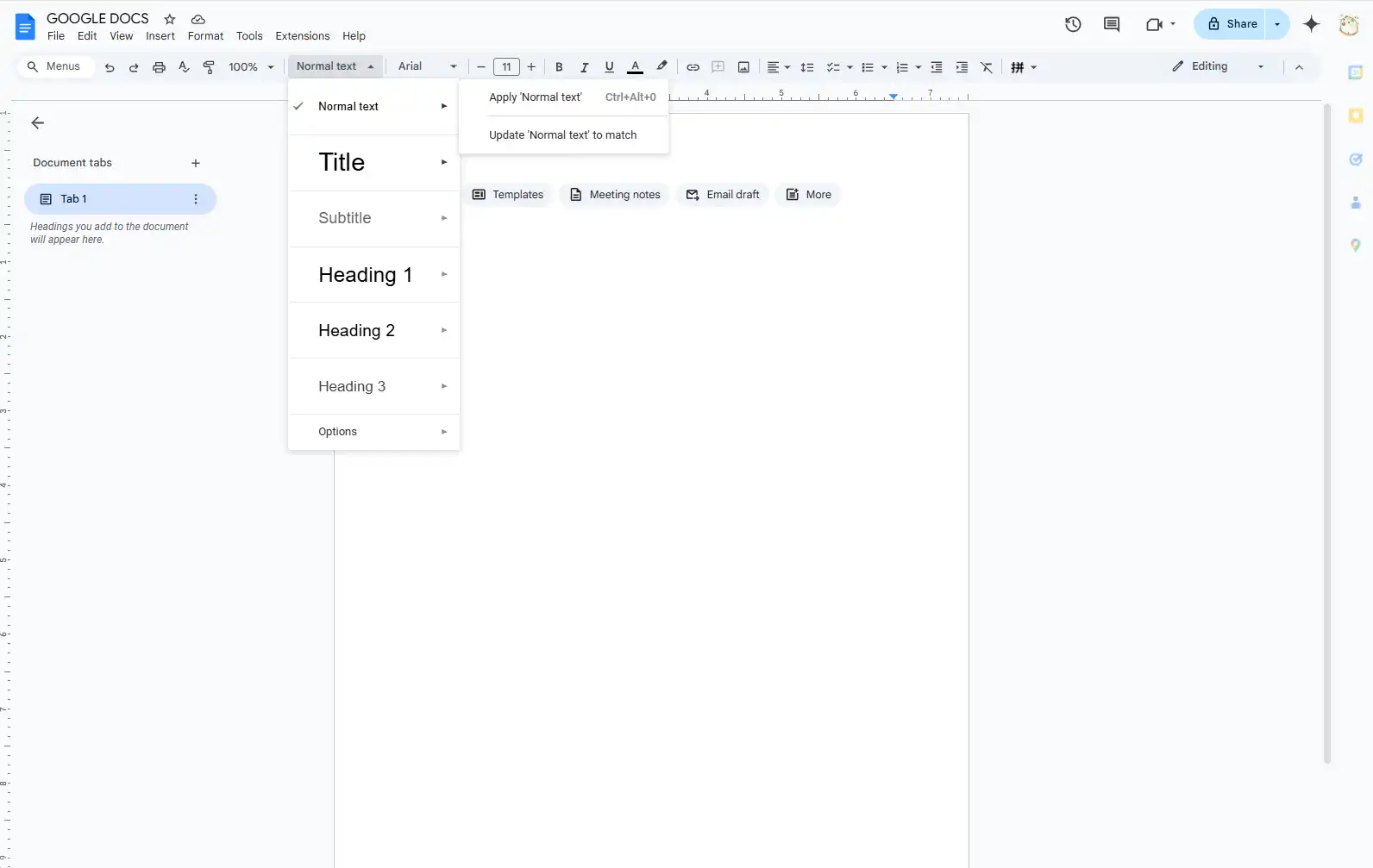
Google Docs provides an excellent cloud-first approach to document creation with industry-leading collaboration capabilities.
Key Features:
- Real-time collaboration with multiple users
- Automatic saving to Google Drive
- Comprehensive sharing controls
- Version history with restore options
- Offline editing capabilities
- Voice typing and smart compose
Pros:
- Best-in-class collaboration features
- Accessible from any device with a browser
- Free for personal use
- Regular feature updates
- Strong integration with Google Workspace
Cons:
- Requires internet connection for full functionality
- Less powerful formatting than desktop alternatives
- Privacy concerns with Google’s data practices
- Feature limitations compared to Microsoft Word
Ideal For: Collaboration-focused Windows users, cross-platform workflows, users comfortable with web applications
Pricing & Platform: Free with Google Account, Web-Based, Cross-Platform
8. Best “Hidden Gem” Document Software for Windows: FreeOffice TextMaker
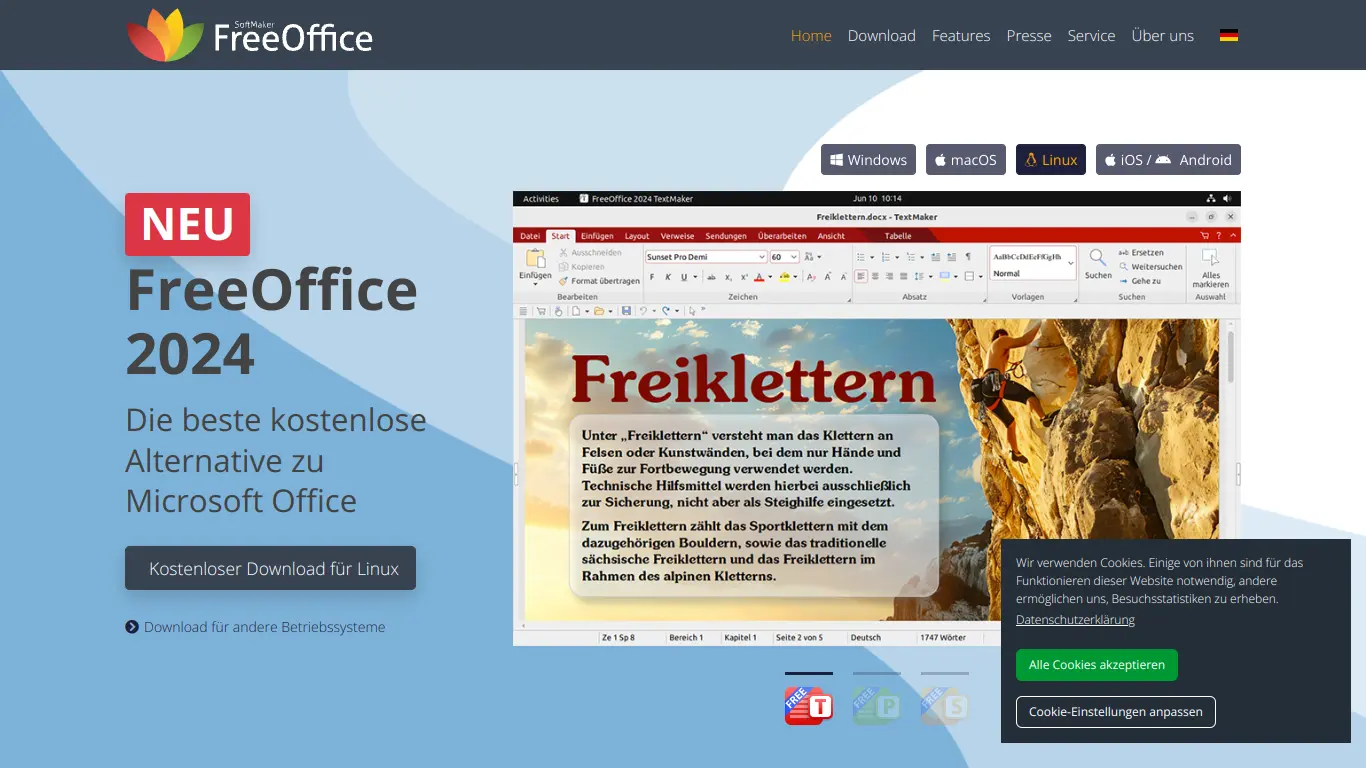
SoftMaker’s FreeOffice TextMaker offers a powerful yet underappreciated alternative to mainstream office suites.
Key Features:
- High compatibility with Microsoft Office formats
- Modern ribbon interface similar to Microsoft Word
- Built-in PDF creation
- Tabbed document interface
- Comprehensive formatting tools
- Track changes functionality
Pros:
- Free version with substantial capabilities
- Familiar interface for Microsoft Office users
- Lightweight and fast performance
- Solid file compatibility
- No ads or forced registrations
Cons:
- Less known than mainstream alternatives
- Premium version needed for some advanced features
- Smaller community for support and templates
- Limited collaboration features
Ideal For: Users seeking a free but capable Windows desktop suite, looking beyond mainstream options
Pricing & Platform: Free Version, Paid Version ($79.95 one-time purchase), Windows
9. Best Simple Text Editor Built-in to Windows: Notepad & WordPad
Windows’ built-in editors provide no-frills options for basic text editing without additional installation.
Key Features:
- Pre-installed on all Windows systems
- Notepad: Plain text editing
- WordPad: Basic rich text formatting
- Extremely lightweight
- Quick loading times
- Simple, distraction-free interfaces
Pros:
- Already available on every Windows system
- No cost or installation required
- Perfect for quick notes or edits
- Very low resource usage
- Familiar to all Windows users
Cons:
- Extremely limited formatting capabilities
- No spell checking in Notepad
- Basic file format support
- No collaboration features
- Limited search and replace
Ideal For: Quick notes, simple text files, pre-installed Windows tools, users needing minimal functionality
Pricing & Platform: Free, Built-in Windows
10. Best Document Software for Desktop Publishing on Windows: Adobe InDesign
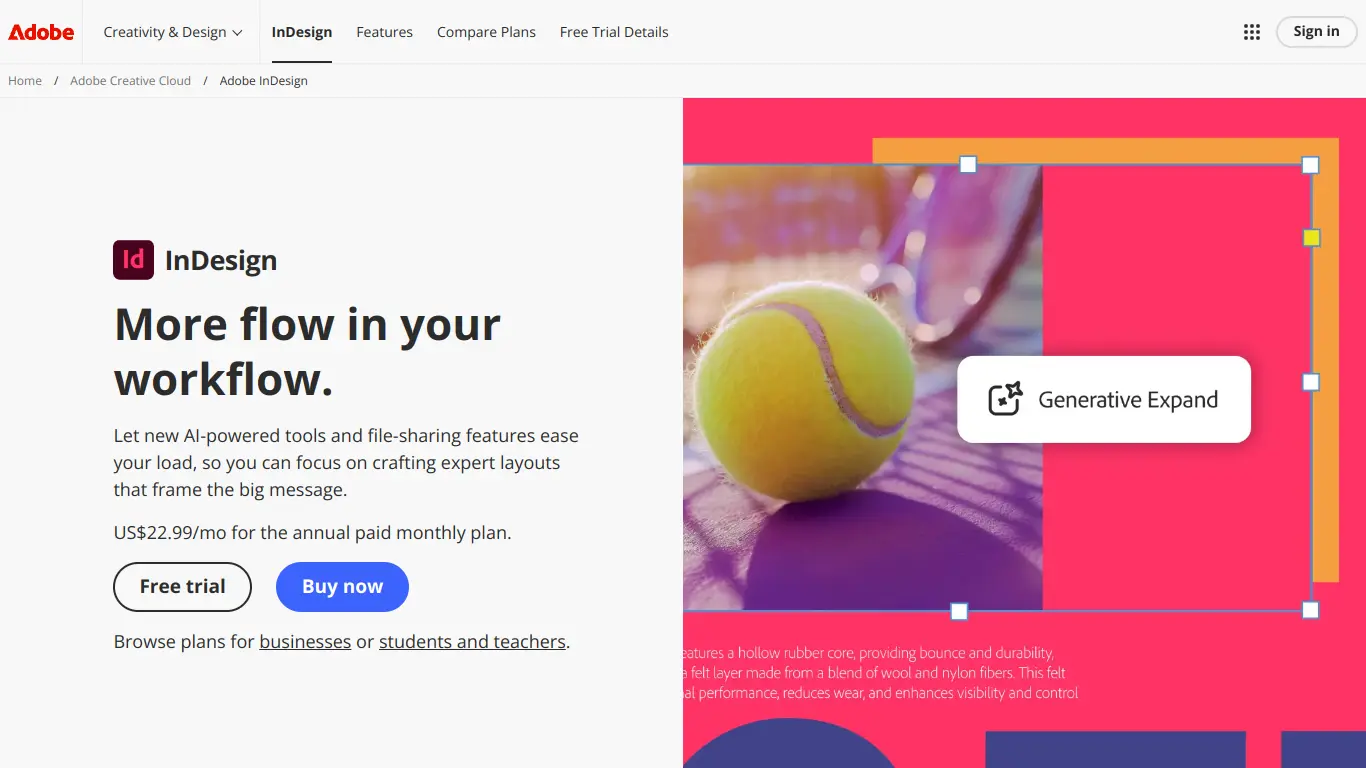
For layout-intensive documents and professional publishing, Adobe InDesign remains the industry standard on Windows.
Key Features:
- Professional layout and design tools
- Advanced typography controls
- Master page templates
- Digital publishing capabilities
- Creative Cloud integration
- Precise control over every design element
Pros:
- Unmatched layout and design capabilities
- Industry standard for publishing professionals
- Regular updates with new features
- Strong integration with other Adobe products
- Extensive template and asset library
Cons:
- Steep subscription cost
- Significant learning curve
- Excessive for simple document needs
- Resource-intensive performance
Ideal For: Designers, publishers, marketers creating brochures, magazines, visually complex documents on Windows
Pricing & Platform: Paid Subscription ($20.99-$54.99/month), Windows & macOS
11. Best Document Software for Technical Documentation on Windows: MadCap Flare
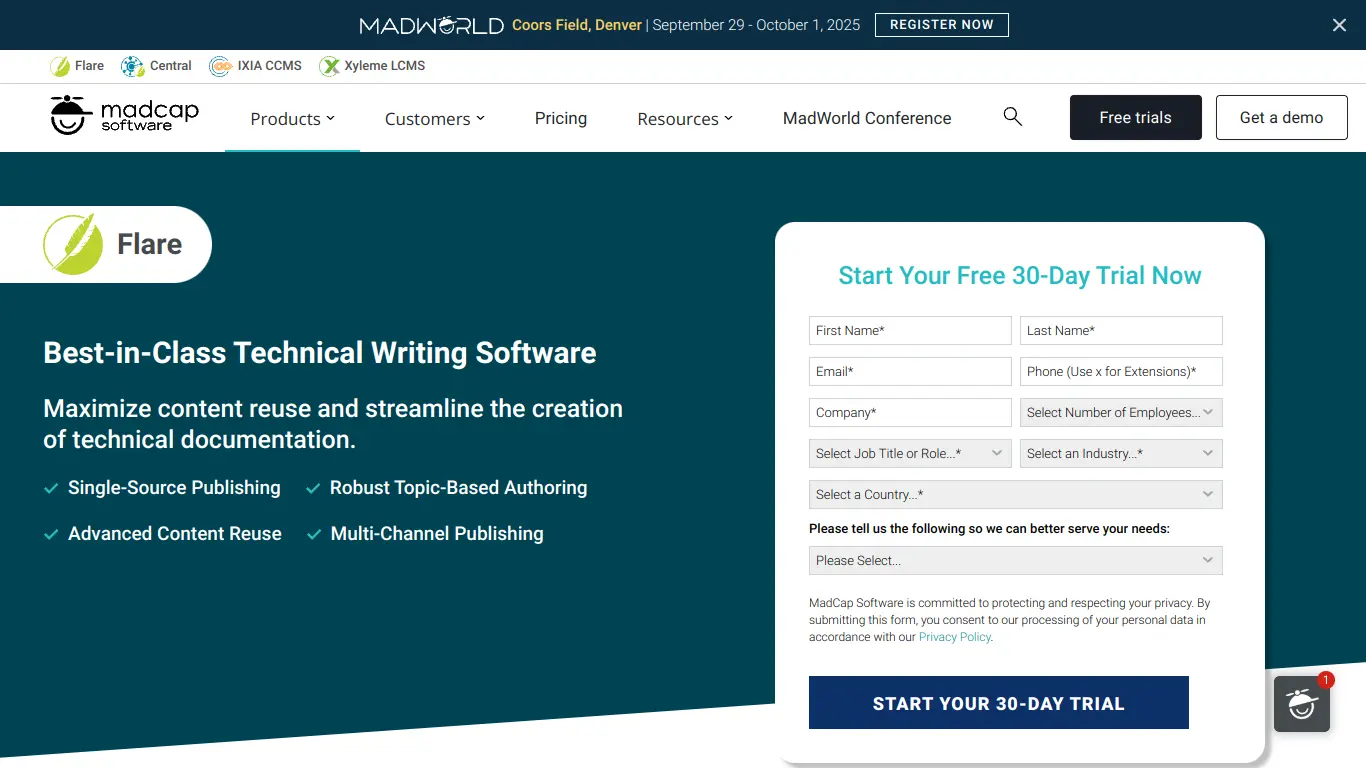
MadCap Flare specializes in technical documentation with powerful single-source publishing capabilities.
Key Features:
- Single-source publishing to multiple formats
- Topic-based authoring
- Conditional content filtering
- Advanced template control
- XML-based architecture
- Robust output customization
Pros:
- Purpose-built for technical documentation
- Powerful reuse of content across documents
- Support for complex documentation projects
- Strong output flexibility (PDF, HTML, Help)
- Content management features
Cons:
- Expensive for individual users
- Steep learning curve
- Overkill for simple documentation needs
- Windows-only operation
Ideal For: Technical writers, documentation teams, software companies creating help files, manuals on Windows
Pricing & Platform: Paid ($1,895 one-time purchase), Windows
12. Best Document Software for Scriptwriting on Windows: Final Draft
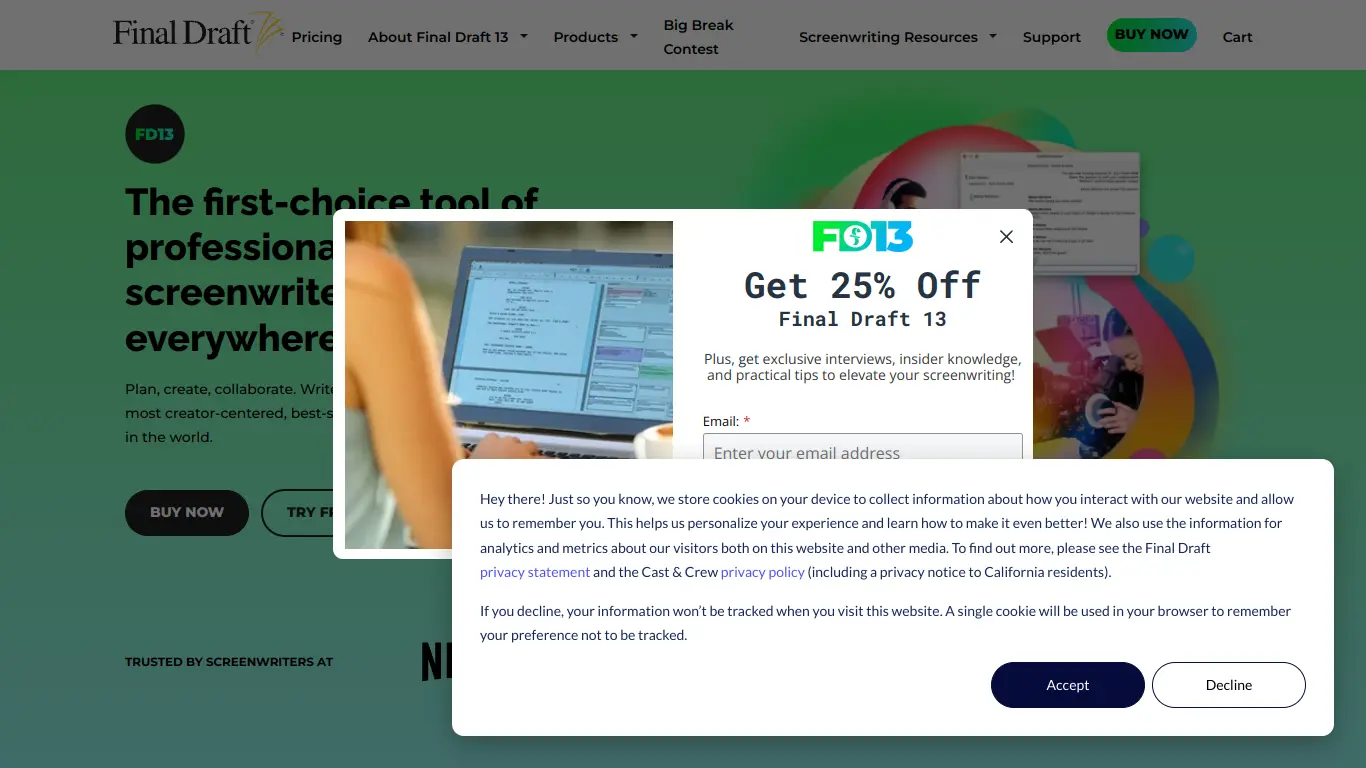
For screenwriters and playwrights, Final Draft provides industry-standard formatting and specialized tools.
Key Features:
- Automatic script formatting to industry standards
- Character and scene management
- Revision tracking with colored pages
- Collaboration tools for co-writers
- Production scheduling features
- Text-to-speech script reading
Pros:
- Industry standard in film and television
- Automatic formatting saves time
- Purpose-built for scriptwriting workflows
- Strong collaboration features for writing teams
- Regular updates with new capabilities
Cons:
- Expensive for casual users
- Focused exclusively on scriptwriting
- Overkill for those not writing standard scripts
- Limited general document capabilities
Ideal For: Screenwriters, playwrights, scriptwriting professionals on Windows
Pricing & Platform: Paid ($249.99 one-time purchase), Windows & macOS
13. Best Document Software for Academic Writing on Windows: Microsoft Word (with EndNote/Zotero Plugins)
Academic writers benefit from Microsoft Word’s robust capabilities enhanced by specialized reference management plugins.
Key Features:
- Academic templates and formatting
- Integration with reference managers (EndNote, Zotero)
- Citation and bibliography generation
- Table and figure captioning
- Track changes for advisor feedback
- Advanced outline and navigation tools
Pros:
- Industry standard in academic publishing
- Powerful plugin ecosystem for academic needs
- Handles large documents with complex formatting
- Strong support for formulas and equations
- Familiar to most academic institutions
Cons:
- Cost of Microsoft 365 subscription
- Learning curve for advanced academic features
- Reference management requires additional software
- Can be unwieldy for very large documents
Ideal For: Students, researchers, academics writing papers, theses, books on Windows
Pricing & Platform: Paid Subscription via Microsoft 365 ($69.99-$99.99/year) with additional plugins like Zotero (free) or EndNote (subscription)
14. Best “All-in-One” Workspace App on Windows with Document Creation: Notion
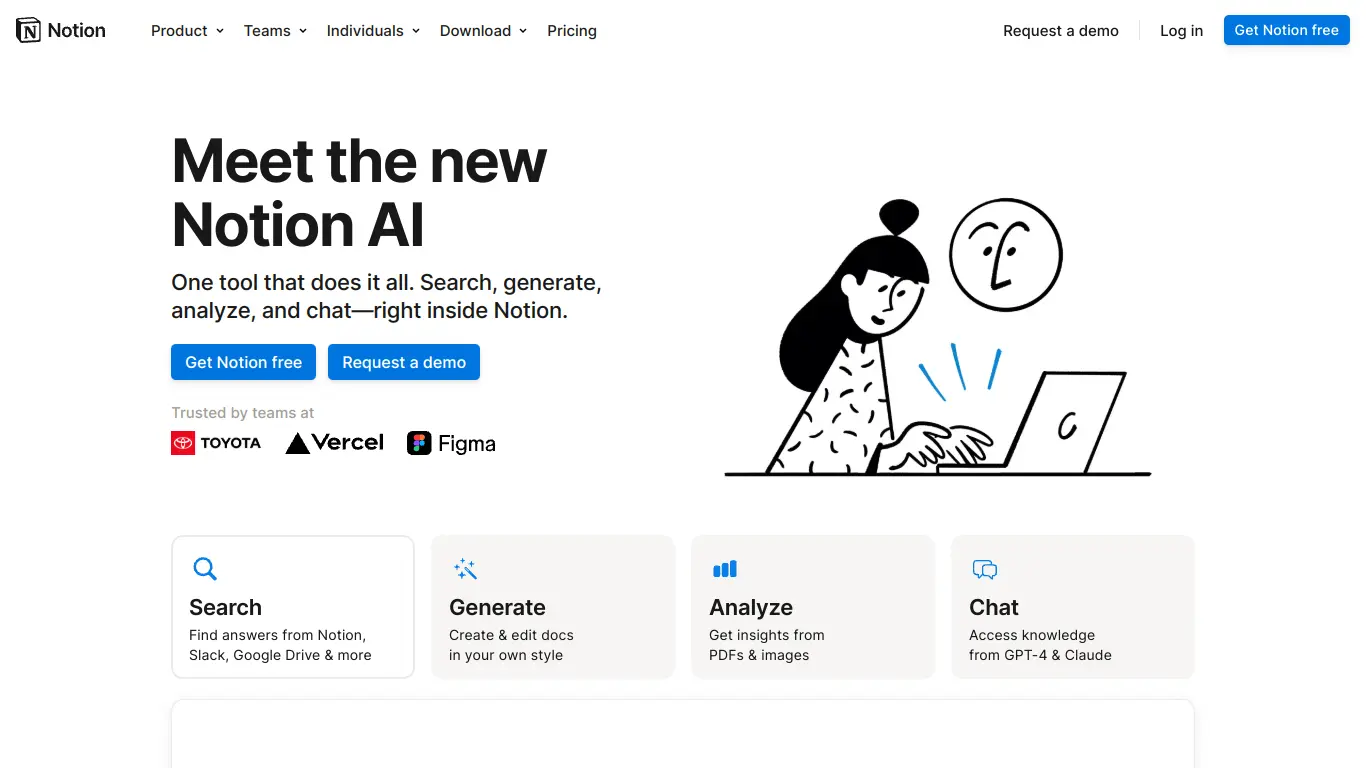
Notion offers a flexible workspace that combines document creation with databases, task management, and more.
Key Features:
- All-in-one workspace combining documents, tasks, and databases
- Highly flexible block-based editing
- Templates for various document types
- Database features within documents
- Cross-linking between pages
- Collaborative workspace
Pros:
- Extremely versatile for various content types
- Combines documentation with project management
- Strong organization through hierarchical pages
- Good collaboration features
- Constantly improving with new features
Cons:
- Learning curve for the unique approach
- Less robust word processing than dedicated tools
- Performance can lag with very large workspaces
- Export limitations compared to dedicated tools
Ideal For: Users wanting an all-in-one workspace on Windows, note-takers, project managers, interconnected information
Pricing & Platform: Free with Paid Plans ($8-$15/month), Windows, macOS, Web, Mobile
15. Comparison Table: Top Document Creation Software for Windows
| Software | Price | Key Strength | Windows Integration | Offline Support | Ideal For |
|---|---|---|---|---|---|
| Microsoft Word | $69.99-99.99/yr | Comprehensive features | Excellent | Yes | Professional documents |
| LibreOffice Writer | Free | Free full-featured suite | Good | Yes | Budget-conscious users |
| WPS Office | Free/Premium | MS Office similarity | Good | Yes | Easy transition from Word |
| iA Writer | $49.99 | Distraction-free writing | Good | Yes | Focused writing tasks |
| Typora | $14.99 | Markdown editing | Good | Yes | Technical content |
| Evernote | Free-$9.99/mo | Note organization | Good | Limited in free | Research collection |
| Google Docs | Free | Collaboration | Browser-based | Limited | Team projects |
| FreeOffice | Free/Premium | Value alternative | Good | Yes | MS Office alternative |
| Notepad/WordPad | Free | Simplicity | Native | Yes | Quick text editing |
| Adobe InDesign | $20.99+/mo | Layout precision | Good | Yes | Visual publications |
| MadCap Flare | $1,895 | Technical documentation | Windows-only | Yes | Tech documentation |
| Final Draft | $249.99 | Script formatting | Good | Yes | Scriptwriting |
| Word+Zotero | Mixed | Academic features | Excellent | Yes | Academic writing |
| Notion | Free-$15/mo | Versatility | Good | Limited | Connected workspaces |
Choosing the Right Document Creation Software for Your Windows PC
Step-by-Step Guide: Selecting the Best Document Software for Windows
Step 1: Define Your Primary Document Creation Needs on Windows
Start by honestly assessing what types of documents you create most frequently:
- Business Reports and Professional Documents: Look for software with strong formatting, templates, and professional appearance
- Creative Writing: Consider distraction-free tools with good organization for chapters and scenes
- Academic Papers: Prioritize citation management, formatting consistency, and structure tools
- Technical Documentation: Seek specialized tools with reusable components and multiple output formats
- Notes and Quick Captures: Favor quick access, search, and organization over formatting power
- Visual Documents: Prioritize layout tools, image handling, and design flexibility
🔍 Pro Tip: Track your document activities for a week to see what you really spend time creating, not what you think you create.
Step 2: Prioritize Essential Features for Your Windows Workflow
Consider which features matter most for your specific needs:
- Windows Integration: How important is seamless integration with the Windows environment and other Microsoft tools?
- Offline Access: Do you need to work without internet connection regularly?
- Collaboration: Will you frequently share and co-edit documents with others?
- Interface Preference: Do you prefer ribbon interfaces, minimal designs, or traditional menus?
- File Format Requirements: What formats do you need to import and export regularly?
- Performance Concerns: Do you work on a powerful machine or an older Windows device?
⚙️ Feature Prioritization Exercise: Create three lists: “Must Have,” “Nice to Have,” and “Don’t Need” to clarify your requirements.
Step 3: Consider Your Budget: Free vs. Paid Software & Long-Term Value on Windows
Document software options range from free to significant investments:
- Free Options: LibreOffice Writer, WPS Office (Free), Google Docs
- One-Time Purchases: Typora, iA Writer, Final Draft
- Subscriptions: Microsoft 365, Adobe InDesign, Notion (premium)
💰 Budget Consideration: Calculate the true cost of “free” options—if they reduce your productivity or require workarounds, they may cost more in time than a paid solution.
Step 4: Evaluate User Interface Preferences & Windows Design Conventions
Different document tools follow different interface philosophies:
- Microsoft-Style Ribbon: Familiar to most Windows users (Word, WPS Office)
- Minimalist Interfaces: Reduced options for focus (iA Writer, Typora)
- Traditional Menus and Toolbars: Classic approach (LibreOffice)
- Block-Based Editing: Modern approach for flexible content (Notion)
🖥️ Compatibility Note: Consider whether you prefer software that follows Windows design conventions or if you’re open to different interface approaches.
Step 5: Try Free Trials & Explore Free Versions of Windows Document Creation Software
Before committing, test drive your top contenders:
- Download free trials of paid software options
- Create similar documents in each to compare workflows
- Test import/export compatibility with your existing documents
- Evaluate performance on your specific Windows machine
- Consider learning curve and training time required
⏱️ Testing Approach: Create the same document in multiple tools to directly compare the experience rather than testing different features in isolation.
FAQs About Document Creation Software for Windows
What is Windows Document Creation Software and Why is it Important for Windows Users?
Windows document creation software refers to applications designed to create, edit, and manage text documents on the Windows operating system. It’s important because it leverages Windows-specific features and optimizations, ensuring smooth performance and integration with the broader Windows ecosystem. For Windows users, using software optimized for their operating system typically provides better performance, familiar interfaces, and seamless integration with file management and printing systems.
Are Best Document Software for Windows Always Paid, or Are There Good Free Options Available?
There are excellent free document creation options for Windows users in 2025. LibreOffice Writer offers a comprehensive free alternative to Microsoft Word with no limitations, while WPS Office provides a familiar interface with a generous free tier. Google Docs offers a robust web-based option that costs nothing for personal use. The best choice depends on your specific needs—while paid options like Microsoft Word offer more features and support, many users find free alternatives completely adequate for their document creation needs.
What Makes an App the Best Document Software for Windows Specifically?
Software optimized for Windows typically offers:
- Native performance using Windows-specific code
- Integration with Windows file explorer and management
- Support for Windows notification systems
- Compatibility with Windows printing infrastructure
- Consistent Windows keyboard shortcuts and commands
- Designed for Windows display scaling and resolution
- Optimization for Windows security and permission models
- Support for Windows-specific features like touchscreen input
- File association handling through Windows registry
These Windows-specific optimizations provide a more seamless experience than cross-platform or web-based alternatives.
Can I Use Online Document Editors Like Google Docs Effectively on Windows?
Yes, online document editors like Google Docs work effectively on Windows through modern browsers like Edge and Chrome. Many online editors now offer offline modes, desktop shortcuts, and progressive web app functionality that make them feel more like native applications. However, they may lack deep Windows integration and typically require internet connectivity for full functionality. For users who prioritize collaboration or cross-device access over deep Windows integration, online editors can be excellent choices.
How Do I Choose Between Different Windows Writing Tools?
Consider these key decision factors:
- Primary Use Case: Match the tool to your most common document types
- Feature Requirements: Identify must-have vs. nice-to-have features
- Budget Constraints: Balance cost against productivity benefits
- Collaboration Needs: Evaluate sharing and co-editing capabilities
- Performance Considerations: Assess how the software runs on your specific Windows device
- Learning Curve: Consider training time against productivity gains
- Integration Requirements: Evaluate how it fits with your other tools
The best choice aligns with your specific workflow and document creation needs.
Are There Document Creation Apps Optimized for Specific Types of Writing on Windows?
Yes, specialized document creation tools excel in specific domains:
- Technical Writing: MadCap Flare offers single-source publishing and component reuse
- Scriptwriting: Final Draft provides industry-standard formatting for screenplays
- Academic Writing: Microsoft Word with Zotero/EndNote handles citations and research
- Creative Writing: Scrivener offers chapter organization and research management
- Legal Documents: HotDocs automates document assembly with templates
- Marketing Materials: Adobe InDesign excels at visual layout and design
For specialized writing, purpose-built tools often provide significant advantages over general-purpose word processors.
How Important is OneDrive Integration for Windows Writing Tools?
OneDrive integration has become increasingly important for Windows users as Microsoft’s ecosystem has expanded. Benefits include:
- Automatic backup and version history
- Seamless cross-device access to documents
- Simplified sharing and collaboration
- Integration with Microsoft 365 applications
- Potential cost savings through bundled storage
However, its importance varies by user. Those deeply embedded in the Microsoft ecosystem will find it valuable, while users who prefer alternative cloud storage (Google Drive, Dropbox) or primarily work offline may find it less critical.
Can I Collaborate with Mac Users if I Use Document Creation Software for Windows?
Yes, collaboration between Windows and Mac users is increasingly seamless in 2025. Cross-platform compatibility comes through several approaches:
- Cloud-based solutions like Google Docs, Microsoft 365 (web versions), and Notion work identically across platforms
- Cross-platform desktop applications like Microsoft Word, LibreOffice, and Adobe InDesign maintain file compatibility
- Common file formats like DOCX, PDF, and RTF work across operating systems
The key is establishing common file formats and collaboration tools at the project outset to minimize compatibility issues.
What are the Latest Trends in Document Creation Software for Windows?
Document creation software for Windows in 2025 shows several emerging trends:
- AI-Assisted Writing: Tools now offer intelligent suggestions, automated formatting, and content generation capabilities
- Hybrid Online/Offline Models: More applications balance cloud connectivity with robust offline functionality
- Block-Based Editing: Flexible content blocks that can be easily reorganized and repurposed
- Focus Modes: Distraction reduction features that help writers concentrate on content creation
- Markdown Adoption: Increasing support for Markdown as a simplified markup language
- Voice Input Integration: Enhanced dictation capabilities with Windows voice recognition
- Improved Collaboration: Real-time co-editing with presence awareness and commenting
- Cross-Device Continuity: Seamless transitions between Windows desktop, mobile, and web interfaces
These trends reflect the evolving needs of document creators balancing efficiency, collaboration, and focus.
Is Microsoft Word Still the Top Recommendation for Windows Document Creation in 2025?
Microsoft Word remains the benchmark for Windows document creation in 2025, particularly for business and professional use. Its comprehensive feature set, familiar interface, and deep Windows integration maintain its position as the standard. However, its dominance has decreased as specialized alternatives have gained traction.
Word excels for professional documents requiring precise formatting, long documents with complex structure, and environments where Microsoft 365 integration matters. However, for specific use cases like distraction-free writing, technical documentation, or visual design, specialized alternatives often provide better experiences. The “best” choice ultimately depends on your specific requirements, budget, and workflow preferences.
Conclusion: Create Powerful Documents with the Perfect Windows Software
Final Recommendations: Empowering Windows Users with the Best Document Creation Software
As we’ve explored throughout this comprehensive guide, Windows users in 2025 have an unprecedented variety of document creation tools at their disposal. The landscape extends far beyond Microsoft Word, with specialized options for every workflow, budget, and document type.
Your ideal document creation software depends primarily on your specific needs:
- For most general users: Microsoft Word remains the gold standard, though LibreOffice Writer offers a strong free alternative
- For distraction-free writing: iA Writer and Typora provide focused environments for content creation
- For specialized documentation: Consider purpose-built tools like MadCap Flare or Final Draft
- For collaboration: Google Docs and Microsoft Word (via Microsoft 365) lead in team-based editing
- For budget-conscious users: LibreOffice Writer, WPS Office, and FreeOffice offer capable free options
Remember that the “best” software isn’t necessarily the one with the most features—it’s the one that best fits your specific document creation needs and workflow preferences.
Unlock Your Writing Potential on Windows: Craft Compelling Documents with the Right Windows Writing Tools
The right document creation software does more than store your words—it shapes your entire writing process. When your tools align with your workflow, they become nearly invisible, allowing your ideas to flow naturally onto the page.
In 2025, Windows users can choose from traditional word processors, distraction-free writing environments, specialized publishing tools, or innovative workspace applications. This diversity means you can find software that precisely matches how you think and work.
As AI assistance, cloud collaboration, and cross-device workflows continue to evolve, Windows document creation software will keep adapting to help you communicate more effectively. By selecting tools that match your specific needs, you’ll not only improve your document quality but also enjoy a more satisfying creation process.
Call to Action: Share Your Favorite Windows Document Creation Software & Windows Writing Tips in the Comments!
What document creation software powers your Windows workflow? Have you discovered hidden gems or developed productivity-boosting techniques that make your writing process more efficient? Share your experiences in the comments below!
We’re particularly interested in hearing about:
- Your favorite Windows writing tools and why they work for you
- Creative ways you’ve customized your document software
- Workflow tips that boost your productivity
- Combinations of tools that work well together
- Experiences transitioning between different writing applications
Your insights might be exactly what another reader needs to transform their document creation process!
Looking for a more comprehensive exploration of document creation tools across all platforms? Check out our expanded guide: Document Creation Tools: The Ultimate Guide to 2025’s Best Options covering Windows, macOS, mobile, and web-based solutions.



